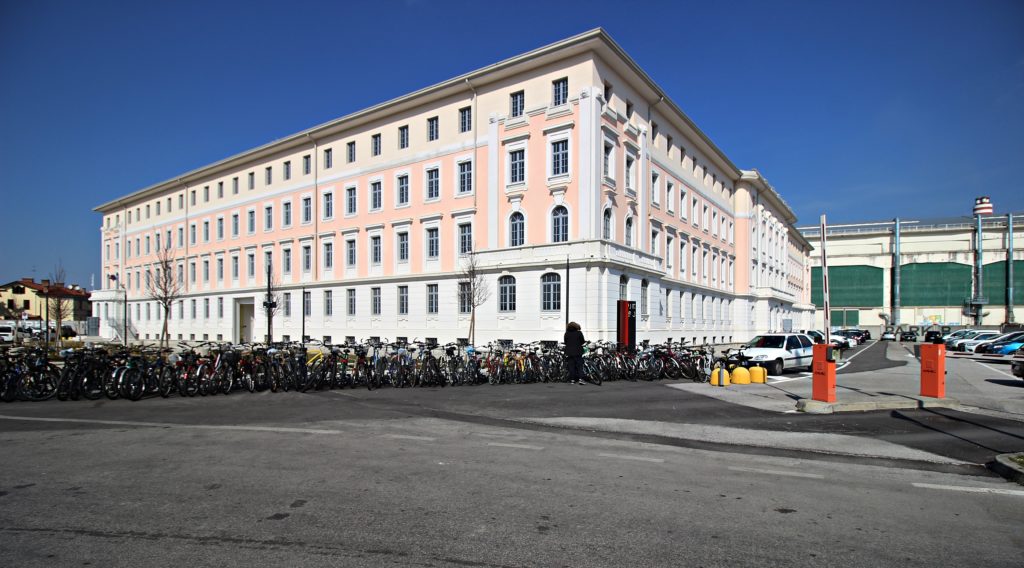One of Europe’s Last Living Company Towns
The most striking feature about industrial heritage is the coexistence of contrasts and contradictions in the places and cities heavily marked by industry in their history and society.
Beauty is not the first thing people link with Monfalcone, a small coastal town in the northeast of Italy, near the Slovenian border. Hard work, immigration and a general sense of greyness emerge in most of the minds, as usual with industrial cities.

But, often, things related with luxury, fashion, craftsmanship and, sometimes, beauty come from such places. That’s true for high-end textiles, sportscars or luxury watches. And ships, as in the case of Monfalcone.
In the early 20th century this swampy area, as the whole northeastern corner of Italy (known today as the region Friuli-Venezia Giulia), was part of the Austro-Hungarian Empire. Industry was booming in and around Trieste, the only major harbour of the state. Sea trade and the related activities, such as shipbuilding, were successful businesses and that’s why the Istrian family Cosulich, owners of a navigation company, decided to open their own shipyard. They chose the bay of Panzano, at the time south of the village of Monfalcone, to build the plant, which launched its first ship in 1908.

The Cosulich distinguished themselves for their social policy towards the yard’s workers. Similar to other industrialists of the time, they built a series of living quarters to ease the hard life of the employees and their families. Houses, shops, sport and leisure facilities started surrounding the immense shipyards, and together they engulfed the old fishermen’s village of Monfalcone, which gained worldwide renown as the town of shipbuilding. The company town of Panzano was designed according to the garden town principles conceived by Ebenezer Howard: the ideal green space where the people could forget the darkness and dirt of the industrial city.


During the First World War, the front lines of the fighting between Italy and Austria raged exactly in these places. After the war, the region became an Italian territory. Monfalcone’s shipyard started an incredible period of growth, building some of the most beautiful ocean liners between from the 1920s to the 1960s. The luxurious ships became a symbol of Italy’s rapid development during the Fascist and Republican period. Prior to that, the young nation struggled with its image as an underdeveloped country. Liners were a synergy of different skills: engineers, welders, electricians and mechanics obviously lent their expertise, but the creativity of craftsmen, interior designers and artists also played a crucial role in perfecting these giants of the sea. Ships like Saturnia, Vulcania, and Giulio Cesare not only carried businessmen and tourists, but also thousands of emigrants between Europe and the Americas: their amazing design, furniture and decoration exported Italian know-how throughout the world that is still the most valuable feature of the so-called “Made in Italy”.



The relation between town and industry is so deep and complex that it’s virtually impossible (and maybe not correct) to look at it in a positive or negative way. The glorious years described before were counterbalanced with the end of the ocean liners era and the restructuring for the cruise ship construction. Major shifts in the industry brought job losses for skilled labourers, an influx of low-cost workers from abroad drove wages down. Industrial hazards such as the plague of asbestos-derived cancer, which killed, and continues to kill hundreds of people who worked near the yard. As they say here: “Everybody has in his family someone that worked in the shipyard, everybody has is his family someone that got cancer”.

“They built the stars of the seas. Killed by the dust, betrayed by the profit”
This sentence summarize at best the story. The factory is a place where wealth and poverty, light and dark, beauty and decay, and sometimes life and death, coexist. In Monfalcone and other places around the world like this. It’s a human story that it’s worth to be told, also because it’s something still going on. State-owned company Fincantieri now runs the shipyard, among the biggest in the Mediterranean Sea. Panzano is also among the last company towns in Europe to still house factory workers. Tours are available in both places, but where the two parts meet and form the story is exactly in the middle.

In the former Albergo Operai (Hotel for single workers), a Secession-styled palace that could easily be in the center of Vienna, the municipality of Monfalcone opened the MuCa (Museo della Cantieristica, Museum of Shipbuilding). Naval-themed museums are often no more than scale models collections, here it’s different, however. The choice of the location is a message about the capacity of creating beauty of the industry. The museum emphasizes the role of industry as a subject able to change and create new landscape, social and urban structures. Industry isn’t obviously a thinking being, but a system set up by humans belonging to different classes (entrepreneurs, professionals, workers, artists) that work together to produce something functional and beautiful.

The MuCa, through a clever yet unobtrusive use of multimedia technologies and augmented reality, brings you in touch with men and women that formed the backbone of this town-industry story. Technology and engineering evolution, the art that decorated the ships or the workers’ theatre, the unions’ fights to save jobs and health, all stay side by side. What the MuCa does at its best is present industrial history in a balanced view. Something that many industrial museums aren’t really able to do.


Never miss Monfalcone and its Shipbuilding Museum if you want to see an “industrial ecosystem” that has not been frozen in the past but it’s still in evolution, relying on the same roots of one century ago: men working together to create something great. And beautiful.

